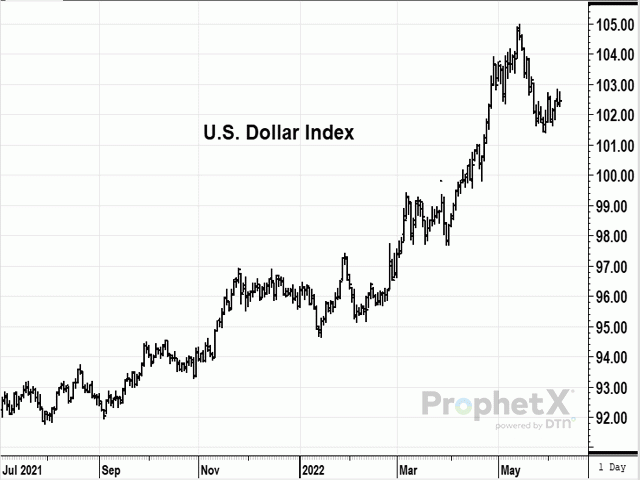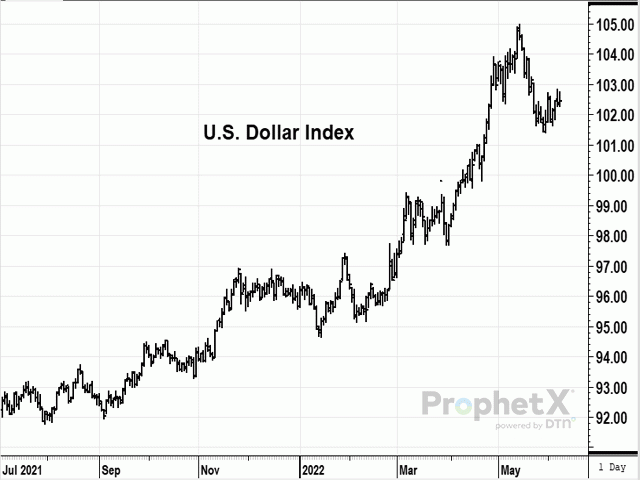An Urban's Rural View
Is the US Dollar Rally Ending?
The U.S. dollar has had a good run during the last year or so. Is that run coming to an end?
Some currency-market players think so. For example, on May 31 UBS, a Zurich-based bank, switched its outlook to "dollar neutral," saying the "USD rally has run its course, and we see limited upside from here." (https://www.ubs.com/…)
A few weeks ago, the dollar started sliding. On May 13, when the greenback hit a 19-year high, the U.S. Dollar Index was up nearly 17% from last June. By May 31, it had fallen 3% from that peak. The index tracks the dollar against a basket of six major currencies (https://www.theice.com/…)
Dollar doubters think some of the forces that have been driving the currency higher are losing strength. Higher interest rates attract foreign capital, which boosts the dollar, but UBS thinks expectations of Federal Reserve rate hikes are "fully priced in." Others note that recent U.S. inflation reports have been edging down, easing the pressure on the Fed to raise rates.
The U.S. economy has been stronger than other developed-country economies, which also attracts foreign capital, but some analysts are seeing subtle signs that it's weakening. Wage growth slowed in the most recent jobs report and sales of new home are falling.
In times of international turmoil, like the Ukraine war, the dollar attracts "safe haven" capital, but UBS thinks even this effect is weakening. "Any worsening of geopolitical concerns should support" the Swiss franc and the Japanese yen, which are also safe-haven currencies, UBS predicted.
P[L1] D[0x0] M[300x250] OOP[F] ADUNIT[] T[]
Whatever the merits of these arguments, the dollar has been rising again the last few days. We'll see soon if the doubters have made their case prematurely.
Does a strong dollar matter? The usual answer is a strong dollar hurts exports, and the dollar's strength has attracted attention recently because big multinationals like Microsoft have warned it's affecting their earnings. Yet overall, U.S. exports have been rising.
Last year, they were 18.5% higher than 2020 and in March they were up 5.6% from February and $34.8 billion more than a year earlier. (The U.S. has been running enormous trade deficits nonetheless because imports have risen even faster.) (https://www.bea.gov/…) and ( https://www.bea.gov/…)
Does a strong dollar matter to farmers and ranchers? USDA is predicting record ag exports for fiscal 2022, and last month it raised its forecast yet again. (https://www.ers.usda.gov/…)
On May 18, DTN Contributing Analyst Elaine Kub wrote, "... with a tenth of the world's agricultural exports still disrupted by the Russian war, corn at $8, soybeans at $16.50, wheat skyrocketing past $13 per bushel, and a severely problematic spring planting season -- who cares about the dollar?" (https://www.dtnpf.com/…)
Prices are down since she wrote that, but they're still relatively high -- and it wasn't the dollar that pushed them down. With the world worried about possible food shortages, importing countries remain less price-sensitive. That won't last, though, and given a choice, exporters will always pick a weaker dollar, even if it's not hurting them much at the moment.
If, like me, you studied economics prior to 1971, when President Richard Nixon cut the dollar loose from its mooring in gold, you may wonder how a country with a 12-digit trade deficit can have a strong currency. In a fixed-exchange rate world the market would tend to push the exchange rate down, in the process helping correct the trade deficit.
In the floating-rate world in which we've lived since the '70s, flows of investment money often dwarf trade-related flows. Foreign investors put their money where they think they'll get the best returns. That's often the U.S., despite its trade deficits. It has been recently.
Last December, the London-based Economist published a piece headlined, "Why the dollar's ascendancy won't last." (https://www.economist.com/…) It contended that the dollar would weaken when three conditions were met -- a narrowing of the "global growth gap," lower U.S. inflation and a less hawkish Federal Reserve stance on interest rates.
The piece was published before Russia invaded the Ukraine and thus did not take into account the invasion's inflationary implications or the safe-haven lift it would give the dollar. That said, the three conditions seem sensible. Yet, despite the subtle signs of change some see, none of the Economist's conditions have yet been met.
My instinct is the doubters are underestimating the Fed's determination to kill inflation. Price increases would have to recede a lot for the Fed to abandon its hawkish course. The dollar rally will end someday, and this may be the day, but don't be surprised if it isn't.
Urban Lehner can be reached at urbanize@gmail.com
(c) Copyright 2022 DTN, LLC. All rights reserved.






Comments
To comment, please Log In or Join our Community .